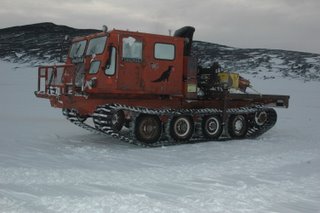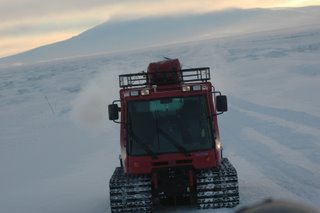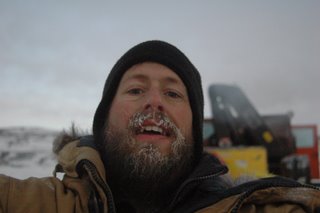
...Properly called a Nodwell. It's a 1982 model of a tracked vehicle manufactured my Canadian Foremost. I am to drive this calamitous contraption 60 miles across the Ross Ice Shelf from McMurdo Station to Black Island Antarctica. I'm a heavy equipment mechanic tasked with repairing the two generators at Black Island that are down. There are other problems with other systems on the station also. Six other people will be going on the traverse (any overland trip here is referred to as a traverse) with me. We are taking a total of four vehicles. Three of them being Pisten Bullys and the fourth being the aforementioned Nodwell. The Nodwell was brought into the United States Antarctic Program back in the days when each piece of equipment had a unique name. The Nodwell's name is T-Rex. Pisten Bully is a German made ski groomer type of vehicle. It's name is a reference to the French/Italian term “piste”. The Pisten Bully is a great vehicle for its intended purpose but that purpose wasn't to transport scientists and equipment across Antarctica. Despite the snow and ice, this place isn't Squaw Valley.

A Pisten Bully
Black Island gets its name because it is mostly snow and ice free. The katabolic winds here are treacherous and Black Island bears the brunt of their force, scrubbing the island clean of any accumulated snow and ice. The plan was to leave on Monday at 7:15 AM. But high winds in the forecast caused a 24 hour delay to our trip. This worked in my favor as I have a great deal of tasking on my plate and really need to get it done. During the delay our manifest increased by three people as a film crew wishes to go along for the ride. On Tuesday I checked my email at 6:15 to see if we were a go. An email outage prevented anyone from being notified so everyone prepared for going. For my part, this involves starting T-Rex which is no small task considering there isn't indoor parking for vehicles. Think about how hard it is to start your car when it's cold outside and multiply that by ten. The temperatures are colder, the wind is fiercer and the equipment is older. I also had to load a few “do not freeze” items on T-Rex and gather my personal belongings for the trip. After the preparation I went to the dining facility for breakfast. It was there that I eventually found out that the traverse was postponed another 24 hours. I wondered how Shackleton, Scott and Amundsen were able to do what the did without the benefit of weather forecasters and email.
By Tuesday evening our manifest had grown by another person. This time a cook and friend of mine from former trips into the Antarctic hinterlands. It was a relief to know that I wouldn't have to rely on boil-in-the-bag type backpacker food. As the day went on, I realized that my luggage for the trip was getting heavier as I kept thinking of items that might be good to have along. As time would soon tell, this was a good thing.
Wednesday morning I received notice that the traverse was a go. I went to the shop, started T-Rex, loaded some last minute items then went to the galley to meet the rest of the traverse crew. We did some last minute planning, gathered the last of the gear that we would need and departed. I feel it necessary to mention at this point that T-Rex is somewhat of an underdog. The traverse leader commented that the machine probably wouldn't make it as far as “KOA” (a shelter about half way between McMurdo and Black Island). When we got to KOA we made a point of radioing back to McMurdo to let everyone know that we had, indeed, made it that far. Very soon after passing KOA we entered what is called the dead zone, so-called because there is no radio communication back to McMurdo from anywhere in the dead zone. It's really pretty ominous. If anything happens while you're there, you're on your own until somebody at McMurdo decides to do something about it. The trip through the dead zone is about an hour long and went by uneventfully. On the other side of it, we promptly checked back in with McMurdo. Soon after our scheduled radio check in, something went horribly awry with T-Rex. I felt something give and heard an atrocious noise from the undercarriage. I brought the machine to a stop and opened my door. Dave, my supervisor and passenger, asked me “What's wrong? Do you smell something hot?”
As I was looking down at the ice, I replied “That thing that I step on to get in and out is gone” The thing that I was referring to was the left side track. It had broken and was laying about 50 feet behind us. “What do we do now?” I thought to myself hopelessly.

Self Laying Track Vehicle Photo: Anthony "Antz" Powell
Dave and I were under great pressure to get this right. It didn't take long for the film crew to get set up and start filming.

The decision making process went into full swing with Dave and myself not wasting any time conferring about what to do or how to do it but rather fiercely attacking the problem at hand. I was able to back T-Rex up mostly straight onto its own track. We used one of the Pisten Bullys to pull the track sideways ever so slightly as I backed T-Rex up. Next, we had to get the other half of the track over top of the drive assembly. We put a few of the grousers over the drive sprocket and engaged the transmission of the machine and it pulled its own track over. That maneuver concluded the easy part. In order to complete the repairs, we would have to come up with material to mend the break and we would need to get enough slack in the track to bolt the two ends together. Fortunately for us, the break had happened in a previous patch. We could simply remove both halves of the patch and use the longer piece to go back in place and bolt less of it to the existing track. T-Rex has an air compressor and I was well equipped to deal with any situation. I got an air impact wrench and an air hose from my tool kit and spent a good bit of time unbolting six track grousers. That done, we only had to figure out how best to re-use the old section of track patch and get slack in the track. The track is tensioned by a cylinder packed with grease. Dave and I are both experienced mechanics. By experienced, I mean that we both know the consequences of removing a fitting that has grease under pressure behind it and neither of us was willing to take a face-full of frozen, pressurized grease. We also had no way of putting grease back in the cylinder once the pressure was off. It was getting late and dark and the decision was made for us to ride in the Pisten Bully back to camp, get some rest and come up with a plan to finish the repairs to T-Rex.
That night, I slept in the bunkhouse at Black Island. The bunkhouse is a building that I would come to know, like many before me, as “the night train” When the wind starts blowing the bunkhouse creaks and sways. The low rumbling and gentle rocking resemble the feeling and sound of being aboard a train. When the winds are calm, the night train is unbearably hot, especially in the top bunk that I was in. When the wind picks up to about 40 knots the temperature drops to comfortable when the wind is harder than that, the bottom bunks are, apparently, unbearably frigid.
When the wind starts blowing the bunkhouse creaks and sways. The low rumbling and gentle rocking resemble the feeling and sound of being aboard a train. When the winds are calm, the night train is unbearably hot, especially in the top bunk that I was in. When the wind picks up to about 40 knots the temperature drops to comfortable when the wind is harder than that, the bottom bunks are, apparently, unbearably frigid.
After a night of insufficient sleep I woke to the howling of winds in excess of 40 knots. The short 50 yard walk to the main building was grueling. There was no chance of going out to complete the repairs on T-Rex in weather such as this so I opted to work on what I was here for, the generators. The first generator that I worked on proved to be a relatively easy fix. Engine vibration had shaken a wire loose on the starter and I was able to fix it by crimping the wire on tighter. The other generator is a victim of being near the end of the earth's longest logistical chain. Absent proper parts to repair things, equipment gets cobbled together by whatever means available to make them work. This is just a fact of life in Antarctica. Unfortunately when these types of repairs are made they make little, if any, sense to the next person to come along. After a series of such repairs it becomes impossible to make the equipment work like it's supposed to again. In the end, the second generator was not repaired and will have to be completed on another trip.
The next day I woke in a puddle of sweat. A calm night in the night train was indicative of calm winds. Dave and I spent a few hours cleaning snow out of Pisten Bullys and getting two of them started. We needed one to venture back to T-Rex and wanted a second one running in case something happened and we needed help. Due to all of this, we got a late start. We arrived at T-Rex at 12:30 PM and made a decision to return to camp no later than 4:30 so that we wouldn't have to try to find our way back in the dark. The road is marked by bamboo poles that are supposed to have flags on them, but the flags have all been violently ripped off by the high winds. Trying to navigate this route in the dark, under whiteout conditions would be extremely difficult as we would later find out. Soon after we arrived at T-Rex the wind picked up. Ambient temperatures were a brisk -22 F. Wind chills were off the chart. Dave commented “I have been this cold before, but never so quickly”.
We took frequent breaks and kept an eye on one another to avoid cold-weather injuries such as frostbite. The work was painfully slow. Fine motor skills become severely diminished when all one thinks about is how cold they are. Skills are further diminished by the necessity of wearing gloves. Touching frozen metal with bare hands in these temperatures instantly produces a sensation much like a burn. As 4:30 approached and then passed we hadn't accomplished much. By 5:30 we were close enough to having the track back together that it was extremely difficult to quit now, but in the interest of our survival we stopped and headed back to camp. The drive back took twice as long as normal due to the inferior visibility. By the time we returned to camp, our stress levels were elevated and a drink was in order.
Saturday proved to be another calm day. Temperatures were considerably warmer and the wind hadn't blown overnight. Pisten Bullys started with ease and didn't require any shoveling out. We arrived at T-Rex at 9:30 AM and had it back together by 11:00 AM. I drove it back towards camp and parked it about 20 minutes away to avoid driving the fragile track across the abrasive volcanic rock of Black Island. By the time we got back to camp, the wind was starting to pick up. Before this night was up, the winds would peak at 97mph. I slept on the floor of the main building that night as getting to the bunkhouse was impossible due to the high winds.
T-Rex was in need of fuel if we were to drive it home. By noon on Sunday the winds had subsided enough to facilitate taking some fuel to T-Rex. We made two trips with six 5-gallon cans. We filled the machine with fuel and pumped the tensioning cylinder up with grease. After the second trip we crossed our fingers and hoped for all to go well the next day so that we could return to McMurdo.
Monday morning was one of the most beautiful I have ever seen. The sky was displaying a magnificent array of colors that are only possible here. The air was silent, crisp and clean. The weather forecast was favorable so the decision was made for seven of us to return to McMurdo in two vehicles. T-Rex and a Pisten Bully. We departed at about 10 AM drove for an uneventful five hours back to McMurdo.
Every moment that I spent on the ice-shelf was pure misery. The constant drone of T-Rex's engine, the bitter cold, the stinging of ice crystals and volcanic pebbles hitting my face, my eyeballs freezing shut, every moment of it was agonizing and grueling. Sharing this with another person formed a bond that can't be formed anywhere else. This is why I am here. This is the Antarctica that I came here to experience. We completed the traverse without help from anyone. We proved to be completely self-sufficient under impossible circumstances. I was able to take great pride in the smallest of victories such as getting a bolt through a hole in T-Rex's track. Such accomplishments are taken for granted in normal circumstances but Antarctica is far from normal and accomplishments here are always grandiose.
Upon my return to McMurdo I took my first shower in six days and was welcomed back by my peers in much the same fashion that celebrities are welcomed. For the second time in less than a month I have returned to McMurdo and felt at home.
Oh..and sometimes just like in the movies, the underdog wins!
Snotsickle: A Self-Portrait
No comments:
Post a Comment